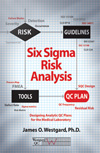Essays and Publications
How is Risk Assessed?
One of the critical early steps of Risk Management is Risk Assessment. There are a multitude of approaches to Risk Assessment, with varying degrees of complexity. Dr. Westgard examines the different approaches and makes recommendations on optimization and customization of these techniques for the healthcare laboratory. (Preview)
- Critical Variables in Risk Assessment
- Risk Assessment Adaptations for Analytical QC
- Comparison of Risk Models
- What's the Point?
- References
The most commonly used tool for Risk Assesment is called Failure Modes Effects Analysis (FMEA), which has been around for many years in the manufacturing industry. Given this long history, there are books on the subject, such as a text of some 500 pages by Stamatis [11], a monograph of 90 pages by McDermott, Mikulak, and Beauregard [12], and a pocket guide of 40 pages by Dailey [13]. In the laboratory literature, some of the earliest references to FMEA are a paper by Jan Krouwer that appeared in 2004 [14] and his book on Managing Risk in Hospitals published by AACC the same year [15]. Powers published perhaps the most readable discussion of Risk Management and FMEA in the journal Lab Medicine [16] in the October 2005 issue that reported on the “QC for the Future” conference held by CLSI on March 18, 2005. The papers reporting on that CLSI meeting [17] provide the context for the development of risk management guidelines for laboratory QC.
The process of conducting a risk analysis using FMEA involves several steps and is analogous to the team problem-solving process for quality improvement. It uses many of the same tools, such as brain-storming, flow-charting, cause-and-effect diagrams, consensus voting, and Pareto prioritization. McDermott et al. outline a ten-step process as follows:
- Review the process or product;
- Brainstorm potential failure modes;
- List potential effects for each failure mode;
- Assign a severity ranking for each effect;
- Assign an occurrence ranking for each failure mode;
- Assign a detection ranking for each failure mode and/or effect;
- Calculate the Risk Priority Number (RPN) for each failure mode;
- Prioritize the failure modes for action;
- Take action to eliminate or reduce the high-risk failure modes;
- Calculate the resulting RPN as the failure modes are reduced.
Typically a flow chart is developed to describe the process under study. Then the potential failure modes are identified for each step in the flow chart. A “fishbone” or cause-and-effects diagram provides a good graphical tool for displaying potential error sources. The “effects” of analytical failure modes typically will be an erroneous test result or a delayed test report, thus the many failure modes lead to a relatively short list of effects. Then comes the rankings of severity, occurrence, and detection, which typically are done using scales of 1 to 10. These rankings are then multiplied together to calculate the Risk Priority Number (RPN = SEV*OCC*DET). These RPNs are typically used quantitatively to evaluate the seriousness of risk and the importance of action on particular failure modes. A Pareto diagram is often constructed to highlight the failure modes with the highest RPNs.
We Invite you to read the Complete Essay
This entire essay, plus many others covering Risk Management concepts, techniques, and implementations, is available in Six Sigma Risk Analysis, a book devoted to the topic of Risk Management, Risk Analysis, and the use of Six Sigma techniques in Risk application for the laboratory.
